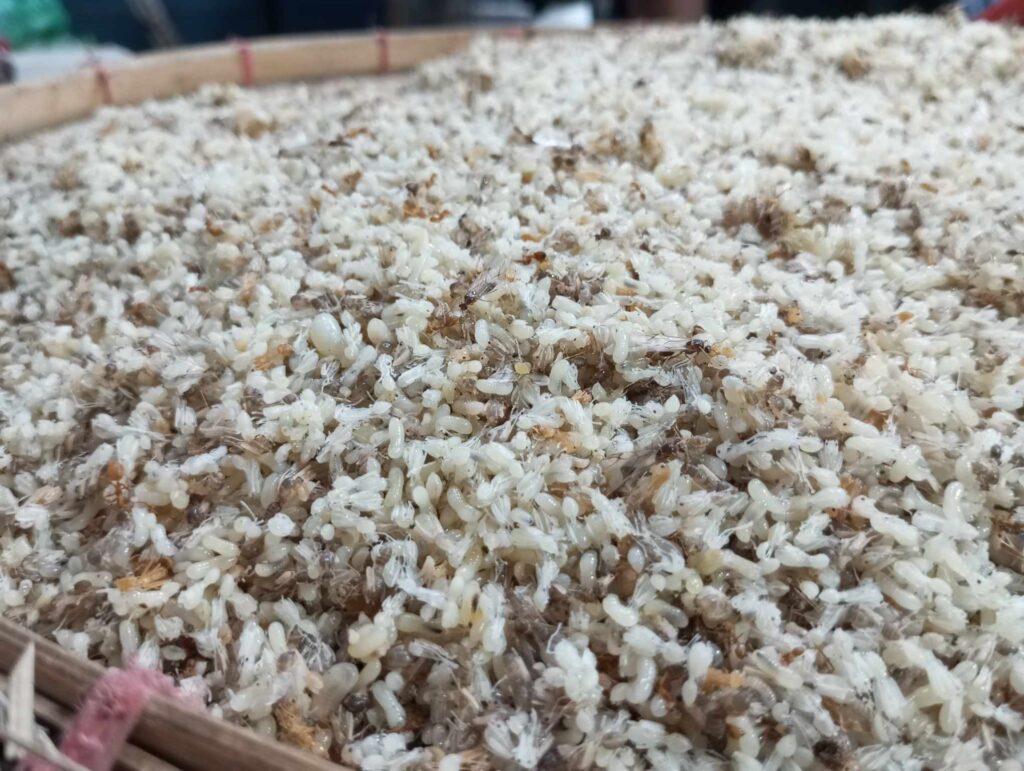Why Use Ant Larvae?
- Natural Attraction: Many fish, especially freshwater species like trout, carp, and various panfish, are naturally attracted to insects and larvae, making ant larvae a highly appealing bait.
- Versatility: Ant larvae can be used in various fishing techniques, including float fishing, bottom fishing, and fly fishing.
How to Collect Ant Larvae
- Finding an Ant Nest: Look for ant nests in soil, under rocks, or in decaying wood. Be cautious and wear gloves to avoid ant bites.
- Collecting Larvae: Gently disturb the nest and use a small brush or stick to collect the larvae. Place them in a container with some of the nest material to keep them alive and fresh.
Storing Ant Larvae
- Short-Term Storage: Keep the larvae in a cool, dark place with some of the nest material to maintain their natural environment.
- Long-Term Storage: For longer storage, place the larvae in a breathable container and store them in the refrigerator. Avoid freezing, as it can kill the larvae.
Using Ant Larvae as Bait
- Hooking Ant Larvae:
- Use a small, fine wire hook to avoid damaging the delicate larvae.
- Hook the larva gently through the head or body, ensuring it remains lively to attract fish.
- Float Fishing:
- Attach the baited hook to a float rig and cast it into the water. Adjust the depth of the float so the larvae are suspended at the desired depth where fish are feeding.
- Bottom Fishing:
- Use a weight to sink the baited hook to the bottom. This method is effective for bottom-dwelling fish like carp and catfish.
- Fly Fishing:
- Ant larvae can be used as part of a fly fishing setup. Tie an artificial fly that mimics the appearance of ant larvae, or use real larvae on a fly hook.
Enhancing Effectiveness
- Ground Baiting:
- Mix ant larvae with other ground baits like breadcrumbs, cornmeal, or fishmeal to create a chum that attracts fish to your fishing spot.
- Scatter this mixture in the water around your fishing area to draw fish closer.
- Combination Baits:
- Combine ant larvae with other baits, such as maggots or worms, to increase the attractiveness of your bait.
- Experiment with different combinations to see what works best in your fishing location.
Tips for Success
- Handling: Handle ant larvae with care to avoid crushing them. Using a small, soft brush can help transfer them to the hook without damage.
- Location: Use ant larvae in areas where fish are known to feed on insects. Streams, rivers, and ponds with abundant insect life are ideal.
- Timing: Fish are often more active and likely to feed on ant larvae during early morning and late evening hours when insects are naturally more prevalent.
Environmental Considerations
- Sustainable Collection: Avoid over-harvesting ant larvae from a single nest to ensure the ant colony can recover and continue to thrive.
- Local Regulations: Check local fishing regulations regarding the use of live bait and ensure that using ant larvae is permitted in your fishing area.
Using ant larvae can significantly enhance your fishing experience by providing a natural and effective bait option. With proper collection, storage, and application techniques, you can attract a variety of fish species and increase your chances of a successful catch.
